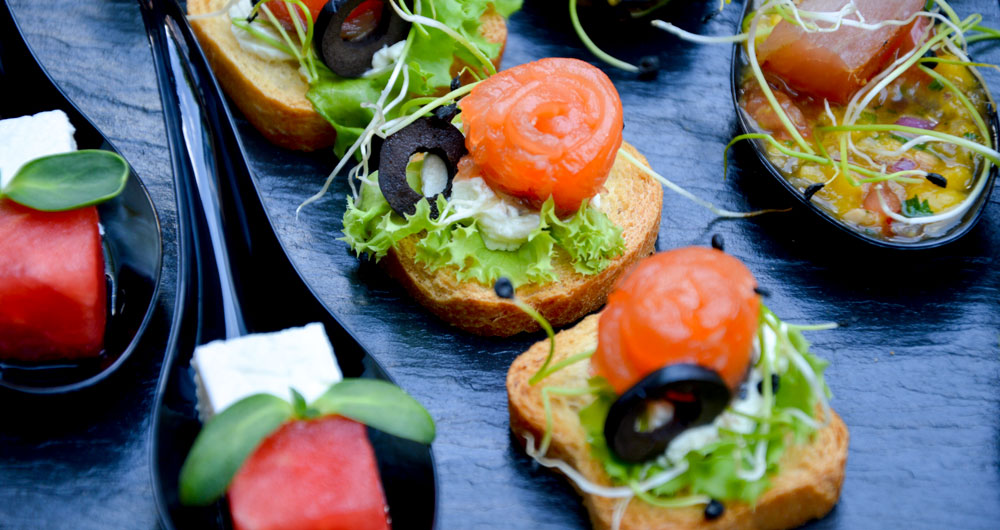Guide for Mastering Event Menu Planning: 10 Tips and Considerations for Your Next Event
Every event planner knows that one of the standout features of any event, be it a wedding, corporate gathering, or birthday party, is the food. The aroma, taste, and presentation of the dishes can elevate the entire experience, leaving an indelible mark on the attendees' memories. However, planning the perfect menu is no small feat.
Let's dive into the essentials of menu planning in event management and explore some vital tips and considerations.
Understanding the Importance of Menu Planning
The menu is not just a list of dishes. It's a sensory journey, a reflection of the event's theme, and often, the most discussed aspect of any gathering. Whether you're aiming for a traditional feel or a modern twist, your menu can set the tone, making it essential to give it the attention it deserves.
1. Know Your Audience
Before drafting a menu, it's crucial to understand the demographic of your attendees. For example, if your audience is diverse, be aware of cultural dietary restrictions and preferences. For instance, serving pork might not be suitable for a Muslim audience, and beef might be off the table for Hindus.
Event age demographics matter - Younger audiences might appreciate a more adventurous or trendy menu, while an older demographic might lean towards classic dishes. Other things to consider when it comes to your audience and their food preferences could be:
- Sustainability/how you're sourcing your food
- Dietary preferences
- Portion sizes
- Food safety (could determine serving style)
- Meal preferences (breakfast, lunch, dinner)
- Cultural background and preferences
2. Dietary Restrictions and Allergies
In today's health-conscious world, it's crucial to consider dietary restrictions like we mentioned above:
-
Vegetarian and Vegan: Always include vegetarian and vegan options. Not only is it considerate, but it's also becoming a standard practice.
-
Allergies: Be prepared for common allergies like nuts, dairy, and gluten. Clear labeling and communication are crucial.
-
Special Diets: Consider diets like Keto, Paleo, or Low-FODMAP and include a few dishes to cater to these preferences.
A good idea would be to conduct a survey or assessment on your target market to determine common dietary restrictions you could face.
3. Seasonality is Key
Incorporating seasonal ingredients ensures freshness, better taste, and often, lower costs. A winter event might feature hearty stews and roasts, while a summer gathering could focus on light salads and grilled dishes.
Rolling with the seasons is also a sustainable practice to work with local crops and farm-to-fork farmers.
4. Diversity in Dishes
Texture plays a pivotal role in how we perceive and enjoy food. By combining different textures in a menu, chefs can create a multi-layered dining experience. By juxtaposing contrasting textures like crunchy and soft, the dishes can stimulate the palate and make the dining experience more intriguing.
Examples of Diverse Textures in a Menu:
-
- Crispy: Think of deep-fried calamari or crunchy bruschetta.
- Creamy: This could be a potato puree or a velvety cheesecake.
- Tender: Slow-cooked meats or steamed fish.
- Firm: Grilled vegetables or al dente pasta.
-
Flaky: Pastries or a perfectly baked fish.
Every cuisine has its unique set of flavors, but for a balanced and diverse menu, it's essential to incorporate a range of tastes. Too much of one flavor can overwhelm the palate. Balancing them ensures that each dish shines and complements the others.
Exploring Different Flavors:
-
- Sweet: This isn't limited to desserts. Incorporate sweet elements in savory dishes, like a sweet glaze on roasted meat or fruit in a salad.
- Salty: Essential for enhancing flavors. Consider dishes like salt-crusted fish or bacon-wrapped dates.
- Bitter: Can be introduced through ingredients like radicchio, arugula, or dark chocolate.
- Sour: Citrus fruits, fermented foods, and vinegar can bring a refreshing tanginess.
-
Umami: Often described as the 'fifth taste,' umami adds depth. Ingredients like mushrooms, tomatoes, and soy sauce are rich in this flavor.
Diversity in dishes is more than just a culinary trend; it's a testament to the chef's creativity and understanding of ingredients. By crafting a menu that offers a symphony of textures, flavors, and cooking techniques, diners are treated to not just a meal, but a journey of culinary discovery.
5. Quantity Matters
The number of dishes you offer on your menu will depend on the event type:
-
Cocktail Events: Focus on a variety of appetizers and finger foods.
-
Buffets: Offer a broader selection, ensuring each attendee finds something to their liking.
-
Sit-down Dinners: Typically, a three to five-course meal is standard, but always ensure portion sizes are appropriate.
6. Taste and Presentation
Before finalizing the menu, have a tasting session. Ensure the dishes are up to the mark in taste, presentation, and portion size. This session can offer insights and allow for tweaks.
Presentation Matters:
We often "eat with our eyes first." A dish that is visually appealing can elevate the entire dining experience. During the tasting session, it's crucial to ensure that each dish's presentation is impeccable and aligns with the event's theme or tone.
Especially relevant for events, portion sizes should be calibrated to ensure guests are satisfied but not overwhelmed. Testing portions during tasting can help in gauging the right amount for each dish.
7. Consider the Venue and Logistics
When planning a menu for an event, it's easy to get caught up in the creative aspects of dish selection and flavor combinations. However, practical considerations related to the venue and logistics are equally crucial. The location and its facilities can significantly influence the final menu choices and the overall success of the dining experience.
Outdoor vs. Indoor Dining:
-
Weather Considerations: Outdoor events are susceptible to weather changes. Cold weather might require dishes that stay warm longer, while hot weather may necessitate cooler, refreshing menu items. Additionally, certain delicate dishes, like those featuring chocolate or dairy, might melt or spoil in the heat.
-
Pest and Wildlife: Especially in outdoor venues, there might be uninvited guests like insects or animals. This can influence the type of dishes served and how they are presented and covered.
Kitchen Facilities and Infrastructure:
-
Equipment Availability: The chosen menu should align with the equipment available at the venue. For instance, if a dish requires deep frying but there's no fryer, it may need to be reconsidered.
-
Preparation Space: Adequate counter space is crucial for efficient dish preparation. A cramped kitchen can limit the complexity of the dishes prepared.
-
Storage Facilities: Ensure there are enough refrigeration and storage facilities, especially if the event spans several hours or days. This is essential for dishes that need to be stored at specific temperatures to maintain freshness and safety.
Serving Logistics and Scalability:
-
Serving Time: For larger events, dishes should be selected based on how quickly they can be served to prevent long waiting times. This might mean opting for buffet-style serving or pre-plated meals.
-
Maintaining Temperature: If hot dishes are on the menu, logistical considerations should include how to keep them warm, especially when serving a large crowd. This could involve investing in warming trays or portable heaters.
-
Service Staff: The complexity of the menu can dictate the number of service staff needed. For instance, dishes that require last-minute assembly or garnishing might necessitate more hands on deck.
-
Transportation: If the food is prepared off-site, consider how it will be transported to the venue without compromising its quality. Special transportation equipment might be required for certain dishes.
8. Beverages are Equally Important
Pairing the right beverages, both alcoholic and non-alcoholic, can elevate the dining experience:
-
Alcohol: Offer a variety of spirits, and consider signature cocktails matching the event's theme.
-
Non-Alcoholic: Fresh juices, mocktails, soft drinks, and water stations are essential.
9. Don't Forget the Presentation
-
Color Coordination: A harmonious palette can enhance the visual appeal of a dish. Incorporate a mix of colors using vegetables, garnishes, and sauces. For instance, the vibrant green of herbs can contrast beautifully with the deep hues of roasted meats.
-
Layering and Texture: Play with height and layers by strategically placing ingredients. This not only creates a sense of depth but also showcases the individual components of the dish.
-
Garnishes: These should be relevant and edible. While they add to the dish's beauty, they should also complement its flavors.
-
Negative Space: A cluttered plate can be overwhelming. Leaving certain parts of the plate empty can direct the diner's attention and make the dish look more sophisticated.
-
Plate Choice: The size, color, and shape of the plate can influence the overall look of the dish. For instance, a white plate can make colors pop, while a square plate can lend a modern touch.
10. Feedback and Flexibility
In the ever-evolving world of culinary arts and event management, resting on one's laurels is not an option. To ensure consistent success and growth, two key principles are pivotal: gathering feedback and maintaining flexibility. Both elements are critical for refining offerings and addressing unforeseen challenges.
-
Objective Insights: While chefs and event managers may have a vision for their menu, feedback provides an objective perspective on how it was received. It gives a direct insight into the guest's experience, going beyond the theoretical success of a menu.
-
Specific Areas of Improvement: Feedback can shed light on particular dishes that were hits or misses, helping refine future menus. It can also offer insights into portions, presentation, and the overall flow of the meal.
-
Diverse Perspectives: Gathering feedback from a variety of sources – from service staff to guests – can provide a comprehensive understanding of the event's culinary success. Service staff, for instance, might offer insights on dishes that were challenging to serve or present, while guests can comment on taste and satisfaction.
-
Feedback Mechanisms: Use comment cards, digital surveys, or direct conversations to gather feedback. Making it easy for guests to share their thoughts increases the likelihood of receiving constructive input.
|
Ticketing for Taste Events Food fairs, farmers markets, baking competitions - |
Conclusion
Menu planning, while challenging, can be a delightful and rewarding experience. It allows event planners to showcase creativity, cultural sensitivity, and attention to detail. Remember, the goal is not just to fill stomachs, but to satiate souls. A well-planned menu can achieve just that, making the event memorable and leaving attendees eagerly awaiting your next gathering.






